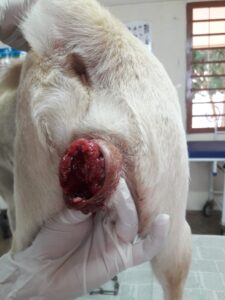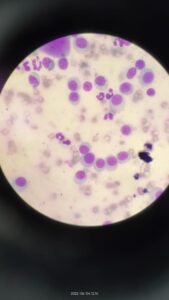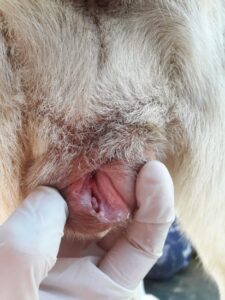Therapeutic management of Canine Transmissible Veneral Tumor (TVT)
- Bhumapati Devi 1*, T. Gyaneshori Devi2 and K. Merina Devi3
1* Assistant Professor, Department of Veterinary Clinical Complex, COVSc & AH, CAU (I) Jalukie, Nagaland, India, 797110.
2Assistant Professor, Department of Livestock Production Management, COVSc &AH, CAU (I) Jalukie, Nagaland, India, 797110.
3Assistant Professor, Department of Livestock Farm Complex, COVSc & AH, CAU (I) Jalukie, Nagaland, India, 797110.
,
Abstract
Canine TVT was first defined by Novinsky in 1876 and confirmed that the tumor could be transferred from one host to another through tumoral cells. It is an infectious tumor of the external genitalia of dogs which is spread during intercourse, licking, snuffing and also by the physical transfer of viable tumours cells by direct contact with wounded skin and /or mucous tissue. It is a sexually transmitted tumor of external genitalia. This viable cell mainly effects the genital region whereas extragenital cases of TVT include, nasal cavity, skin, eye and conjunctiva, buccal and anal mucosa. TVT cells are round, pleomorphic cells, anisokaryosis with multiple nucleoli and coarse chromatin, light basophilic cytoplasm and abundant number of vacuolated cytoplasm. Clinical presentation reveals visible cauliflower-like mass on skin surface with the presence of bloody discharge, ocular or nasal deformation from tumour invasion or in the genital area. Total subsidal result shows with the treatment called chemotherapy with vincristine sulfate @ 0.025 mg/ kg BW weekly internal for 4 weeks.
Keywords: TVT, Cytology, Vincristine sulfate
Introduction
Transmissible veneral tumor (TVT) also known as veneral granuloma, transmissible lymphosarcoma, infectious sarcoma, sticker tumor, is a benign reticuloendothelial tumor of the dog that mainly affects the external genitalia and infrequently the internal genitalia of dogs. Canine TVT was first defined by Novinsky in 1876 and confirmed that the tumor could be transferred from one host to another through tumoral cells. It may spread from animal to animal while copulation (Tella et al., 2004; Igor et al., 2012). Naturally, the tumor occurs in the genitalia of both the sexes. In bitch tumor are present in the vagina or vestibule projecting like a multilobular, cauliflower like shaped (Stockmann et al., 2011) but in male dog tumor are located on Prepucial opening or the penis (Das and Das, 2000; Ferreira et al., 2000). While extragenital TVT is also occurred by social contact, sniffing, licking etc. (Arif et al., 2017) Phimosis and paraphimosis can also developed due to these tumour complication (Das and Das, 2000; Brihan and Chanie, 2015). TVT cells are round with large round nuclei that possess coarse and clumping chromatin and single prominent nucleoli with prominent cytoplasm with distinct vacuolation (Raskin et al., 2010). Normally, the actual chromosome number of dog is 78 but those suffering from TVT, contain an abnormal number of chromosomes ranging 57 to 64 and averaging 59 (Purohit G, 2008). Immunocompromised animals mainly acquire and spread the TVT (Das et al., 2020). Healthy animals are affected due exfoliation and transplantation of the tumor cells from the sick animal. These may grow slowly over years and become invasive, eventually changing to malignant and metastatic (Dar et al., 2017). Considering the treatment point of view radiotherapy, surgical technique, immunotherapy, biotherapy and chemotherapy, chemotherapy has shown to be the most effective and practical therapy with vincristine sulfate @ 0.025 mg/kg BW weekly interval for 4 weeks and the tumor subside after every injection. (Nak et al., 2005)
Transmission of TVT
Presently, TVT arise from allogenic cellular transplants and that the irregular cells of the tumor are the vectors of spreading (Murgia et al., 2006). The exfoliation and transplantation of tunor cells usually transmitted to genital organs during copulation, sniffing, licking, and also by the physical transfer of viable tumour cells by direct contact with injured skin and/ or mucous tissue. If there are abrasion or breaks in the integrity of the mucosal surface, the transmission of tumors is easily be transmitted (Abedin, 2020)
Signs and symptoms of TVT
TVT revealed multilobular typical cauliflower shaped tumorous like growth projecting from the Vestibule of the vagina (Figure1) and in dogs it is located in the shaft of the penis. (Abedin SA, 2020). TVT has cauliflower -like shape, and it could be pendular, nodous, papilar, or multilobular, being friable and red to flesh colored.( Das and Das, 2000). Its surface is often with destruction, ulcera and inflamated. The tumor growth occurs 15 to 60 days after implantation of tumor cells. Normally the dog possesses chromosome number of 78 whereas, TVT cells consists of 57 – 59 chromosomes (Abedin, 2020). TVT cells are large round cells with round or oval nucleus pleomorphic cells, anisokaryosis with multiple nucleoli and coarse chromatin, light basophilic cytoplasm and abundant number of vacuolated cytoplasm (Raskin et al., 2010).
Diagnosis
Clinical sign and symptoms like presence of cauliflower like growth on the glans penis, preputial mucosa or on the bulbus glandis in males and in bitch the tumor like growth if seen in the vestibule and /or caudal vagina. Diagnosis can be made by impression smear of tumor cell and observed under oil immersion microscope (100x) (Sagar et al., 2020). After observation, cells of large round cells with round or oval nucleus pleomorphic cells, anisokaryosis with multiple nucleoli and coarse chromatin, light basophilic cytoplasm and abundant number of vacuolated cytoplasm which is a conclusive of TVT. (Figure 2)
Treatment
The only most effective and practical therapy is the chemotherapy with vincristine sulfate @ 0.025 mg/kg BW weekly interval for 4 weeks totally subsided the tumor (Figure 3) (Mello Martin et al., 2005; Nak et al., 2005). But other therapy like surgery it provides unsatisfactory response due to reoccurrence of tumor. Regarding, radiotherapy even though it yields complete regression, it requires trained workers, expenses and special equipments (Boscos and ververidis 2004).
Prevention
As this tumerous condition occur through copulation mainly with the stray dogs and from transplants tumerous cell from one animal to other animals at the age group of 2 to 8 years. And mainly bitches are more prone to infection than males as a result, owner should be aware during the beeding seasons to prevents from disease animal intercouse with or without strays dogs. The infected bitch should be kept alone in a hygienic way in a kennel. Elizabethan collar should be used to prevent from licking, sniffing to prevent the spread of tumor to other part of the body and one animal to another animal.
Conclusion
TVT is a tumor benign in nature mostly seen in genital region. The animal is affected from the transplant cells of affected dogs. Diagnosis is based on physical and cytological findings. Injection of vincristine @ 0.025 mg/kg BW weekly internal for 4 weeks was found be the most effective therapy.
References
Abedin, S. N. 2020. Canine transmissible venereal tumor: A review. Journal of Entomology and Zoology Studies, 8(2), 596-599.
Arif SA, Das N, Goswami S, Bhuyan M, Mahato G, Pathak M and Das A. 2017. Clinico-pathological study on metastatic form of canine Transmissible Veneral Tumour (TVT) and its therapeutic management. International Journal of Chemical Studies. 5(3): 593-595.
Birhan, G & Chanie, M 2015. A review on canine transmissible venereal tumor: from morphologic to biochemical and molecular diagnosis. Academic Journal of Animal Diseases, 4(3), 185-195.
Boscos, C.M. and Ververidis, H.N. 2004. Canine TVT – Clinical findings, Diagnosis and Treatment. In Proceedings of the 29th World Small Animal Veterinary Association, Oct 6-9. Rhodes, Greece.
Das U and Das AK. 2000. Review of canine transmissible venereal sarcoma. Veterinary Research Communications. 24(8), 545-556.
Dar RR, Islam ST, Rouf A, Wani JM , Dogra P , Sheikh AA, Gupta R, Lakhani N and Ganaie MY. 2017. Cytological Diagnosis and Treatment of Transmissible Veneral Tumor in Dog- A Case Study Int.J.Curr.Microbiol.App.Science. 6(10): 1365-1369. https://doi.org/10.20546/ijcmas.2017.610.160.
Das, D., Kumthekar, S., Manikantha, KGV and Achary, KH. 2020. Sticker tumour (Transmissible venereal tumour) in dog. The Pharma Innovation Journal, SP-9(9), 126-130.
Ferreira, AJA, Jaggy, A, Varejäo, AP, Ferreira, MLP, Correia, JMJ, Mullas, JM, Almeida, O, Oliveira, P, & Prada, J, 2000. Brain and ocular metastases from a transmissible venereal tumour in a dog. Journal of Small Animal Practice, 41(4): 165-168.
G Purohit Canine Transmissible Venereal Tumor 2008. A Review The Internet Journal of Veterinary Medicine Volume 6 Number 1
Igor U, Irena Celeska, Ksenija I, Elena A, Goran N and Plamen T. 2012. Cytological diagnostic of canine transmissible venereal tumor – Case report. Mac Vet Rev; 35 (2): 91-96.
Mello Martins, M.I., Ferreira de Souza, F., and Gobello, C. 2005. The canine transmissible venereal tumor: etiology, pathology, diagnosis and treatment. In: Recent Advances in Small Animal Reproduction. P.W. Concannon, G. England, J. Veretgegen, C. Linde-Forsberg (eds). International Veterinary Information Service, Ithaca NY (www.ivis.org) Apr 25, 2005: A1233.0405.
Murgia, C., Pritchard, JK., Kim, SY., Fassati, A. and Weiss, RA. 2006. Clonal origin and evolution of a transmissible cancer. Cell, 126(3): 477-487.
Nak, D., Nak, Y, Cangul, I.T and Tuna, B. 2005. A clinico-pathological study on the effect of vincristine on transmissible venereal tumor in the dog. J.Vet.Med.A.Physiol.Pathol.Clin.Med. 52(7): 366-70.
Raskin, RE, Meyer, DJ, 2010. Canineand feline cytology: A color atlas and interpretation guide, Second edition, Saunders-Elsevier.
Sagar Regmi, Premlal Mahato, Iebu Devkota, Raju Prasad Neupane, Asmin Khulal and Anil Kumar Tiwary, 2020. Journal of Zoological Research Volume 02 Issue 02.
Stockmann, D, Ferrari, HF Andrade, AL, Lopes, RA, Cardoso, TC & Luvizotto, MCR. 2011. Canine transmissible venereal tumors: aspects related to programmed cell death. Brazilian Journal of Veterinary Pathology, 4(1), 67-75.
Tella, MA, Ajala, OO and Taiwo, VO. 2004. Complete regression of transmissible venereal tumor (TVT) in Nigerian mongrel dogs with vincristine sulphate chemotherapy. African Journal of Biomedical Research, 7(3), 133-138.

Fig 1 TVT revealed multilobular typical cauliflower shaped tumorous like growth projecting from the Vestibule of the vagina |

Fig 2 TVT cells of large round cells with round or oval nucleus pleomorphic cells, anisokaryosis with multiple nucleoli and coarse chromatin, light basophilic cytoplasm and abundant number of vacuolated cytoplasm |

Fig 3 chemotherapy with vincristine sulfate @ 0.025 mg/kg BW weekly interval for 4 weeks totally subsided the tumor |
https://www.pashudhanpraharee.com/treatment-management-of-transmissible-venereal-tumortvt-in-dogs/

